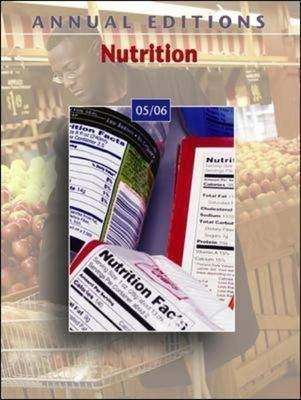
Nutrition
McGraw-Hill Publishing Co. (Verlag)
978-0-07-311220-6 (ISBN)
- Titel erscheint in neuer Auflage
- Artikel merken
This annually updated reader is a compilation of current magazine, newspaper, and journal articles. "Annual Editions" titles are supported with study tools and links to related websites at our student website.
UNIT 1. Nutrition Trends1. The Changing American Diet: A Report Card, Bonnie Liebman, Nutrition Action Health Letter, December 2002A survey by the U.S. Department of Agriculture as to what Americans are eating and the trends of our food consumption over time is presented. Looking at trends since the 1970's our consumption for soda, cheeses, oils, white- and whole-wheat flour, chicken and vegetables has markedly increased while our total whole milk and beef consumption has declined. 2. Dietary Guidelines for Americans 2005: Executive Summary, U.S. Department of Health and Human Services, 2005The 2005 dietary guidelines provide science-based advice to promote health and reduce risk for major chronic diseases. Physical activity and weight management are focal points of the recommendations. Weight management can be achieved by increasing consumption of fruits and vegetables that provide high levels of vitamins A, C, potassium, magnesium, and fiber--nutrients that are lacking in the American diet.3. Rebuilding the Food Pyramid, Walter C. Willett and Meir J. Stampfer, Scientific American, January 2003The authors of the "New Food Guide Pyramid" compare and contrast the U.S.D.A.'s Food Guide pyramid with different glycemic indices with the "New Food Guide Pyramid" that encourages consumption of whole grain foods, healthy fats, deemphasizes meats and dairy, and distinguishes among types of carbohydrates. Furthermore, they propose that the pyramid should be "rebuilt" based strictly on scientific information in an environment away from economic and political pressures. 4. The Low-Carb Frenzy: The Force That is Reshaping the Food Industry and Our Bodies, Daniel Kadlec, Time, May 3, 2004About 26 million Americans are on the low-carb diet and the food industry has drastically increased low-carbohydrate products to meet the demand. Is a low-carb diet a passing fad or is it here to stay? This and other questions are addressed here. 5. Getting Personal with Nutrition, Food Insight, November-December 2003Nutrigenomics is based on the premise that nutrition influences health and that food may also affect gene expression. This article discusses the readiness and acceptability of Americans for personalized nutrition. An explanation of the ethical issues that accompany nutrigenomics is presented. 6. Food, Spirituality, Mindful Eating, Mary Kaye Sawyer-Morse, Today's Dietitian, March 2004Dr. Sawyer-Morse presents a unique way of connecting with our inner selves and the food we eat. Even though food seems to play a prevalent role in the media and our culture, we are more disconnected from food than ever. Exploring the spiritual aspects of food and guiding the reader through steps to mindful eating are part of this article. 7. Who's Filling Your Grocery Bag?, James E. Tillotson, Nutrition Today, September-October 2004A few large food companies fill our grocery bags with high-salt, -sugar, and -fat, snack foods; command a big percent of our food dollars; and have a growing influence on food purchases and our waistlines. Dr. Tillotson believes that although personal behavior plays a big role in the obesity epidemic, mega-snack companies and environmental factors contribute to the problem.8. Moving Towards Healthful Sustainable Diets, Barbara Storper, Nutrition Today, March/April 2003This article focuses on the challenges of nutritionists to educate consumers toward healthful diets that will benefit the environment and support the local economy and agriculture. Ways and resources are offered for consumers to choose minimally processed foods and to buy locally and in season.UNIT 2. Nutrients 9. Omega-3 Choices: Fish or Flax?, Alison J. Rigby, Today's Dietitian, January 2004This article provides a timely update on the health benefits of omega-3 fatty acids and suggests ways to incorporate them in our diet. Recommendations to prevent methyl mercury toxicity from supplement use and fish consumption are presented.10. Revealing Trans Fats, FDA Consumer, September/October 2003The last word on trans-fats and its effects on health is presented by the Food and Drug Administration. Beginning January 2006, the FDA's trans-fat labeling becomes mandatory. Guidance as to reading food labels to detect trans-fat and making healthier fat substitution is offered. 11. Going Beyond Atkins, Walter C. Willet and Patrick J. Skerrett, Newsweek, January 19, 2004In this article, Dr. Willet sets the record straight about carbohydrates and discusses the role of "good" and "bad" carbohydrates as part of a healthy diet. Guidance on choosing the best carbs is also given. 12. Good Carbs, Bad Carbs, Rita Schefrin, Today's Dietitian, April 2003People are confused about what constitutes a good vs. a bad carbohydrate. A detailed explanation of the glycemic index and the glycemic load is given here with guidelines for their use to minimize sharp rises in blood glucose and thus prevent diabetes. 13. Eye Wise: Seeing Into the Future, Bonnie Liebman, Nutrition Action HealthLetter, November 2004Cataracts and macular degeneration are two age-related diseases that can affect your vision. Recent research reveals that antioxidant vitamins C, E, and B-carotene; zinc and foods that contain lutein; zeaxanthin and omega-3 fish oils may have a protective effect on the above diseases.14. Feast For Your Eyes: Nutrients That May Help Save Your Sight, Food Insight, September/October 2002Cataracts and macular degeneration are two age-related diseases that can seriously affect your vision. Recent research studies reveal that antioxidant vitamins such as B-carotene, vitamin C, zinc and yellow-colored carotenoids such as lutein and zeaxanthin may have a protective effect on the above eye disease. 15. Fortifying with Fiber, Linda Milo Ohr, FoodTechnology, February 2004The average American consumes half of the recommended amount of fiber per day. Inadequate fiber consumption and carbohydrate-conscious consumers have aided in the increase of fiber-fortified foods. A description of the ingredients the food industry uses to increase food's dietary-fiber content are listed. Health research and FDA-claims approvals are also presented here.UNIT 3. Diet and Disease Through the Life Span 16. Diet and Genes, Anne Underwood and Jerry Adler, Newsweek, January 17, 2005The interaction between genes and diet determines disease expression. The new science of nutrigenomics ushers in the age of personalized nutrition where dietary recommendations for the population as a whole may be coming to an end. In the near future health professionals will be able to look at the genetic profiles of their patients, identify specific diseases for which they are at risk, and customize nutrition plans accordingly. 17. Prostate Cancer: More Questions than Answers, Bonnie Liebman, Nutrition Action HealthLetter, July-August 2004Even though rates from prostate cancer have decreased since the early nineties, the disease still affects one in six men. Research findings are presented here on food and food supplements that might prevent or retard prostate cancer. 18. Coffee, Spices, Wine: New Dietary Ammo Against Diabetes?, Janet Raloff, Science News, May 1, 2004The number of people with non-insulin dependent diabetes has increased by 50 percent compared to the last decade. Scientists are presently studying the role of coffee, tea, cinnamon, and wine to slow down the onset of the disease and reduce its deleterious effects on the kidneys and blood vessels. 19. Meeting Children's Nutritional Needs, Linda Milo Ohr, FoodTechnology, April 2004Fruits, vegetables, dairy foods, calcium, vitamin D, and fiber are some foods and nutrients that are lacking from children's diets. The food industry is responding to the rise in childhood obesity by offering healthier options and improving nutrition education for parents and children. Some food companies are partnering with the American Dietetic Association and the American Academy of Family Physicians to develop educational outreach programs for children. 20. The Role of the School Nutrition Environment for Promoting the Health of Young Adolescents, May Kay Mayer, John Marshak, and Martha T. Conklin, Middle School Journal, May 2004Despite the rising obesity epidemic among children and adolescents, schools have not placed student health and nutrition on high priority. Schools are in a unique position to ensure appropriate nutrient intake, healthful diets, and nutrition education to students. Some of the reasons and solutions for these problems are explored.UNIT 4. Obesity and Weight Control 21. How We Grew So Big, Michael Lemonick, Time, June 7, 2004The U.S. obesity epidemic is presented and its causes are described in this article. Comparisons among our earliest ancestors and the transition from primitive to present-day diets are made. The reasons why our ancestors did not become obese are discussed. Actions policymakers, such as schools and communities, are taking to reduce the obesity crisis are mentioned. 22. Pandemic Obesity: What is the Solution?, James E. Tillotson, Nutrition Today, January/February 2004Billions of dollars in advertising of fast food, beer, soft drinks, cereals, and bakery products that have a powerful influence on the American diet are discussed. The power of advertising by a few mega-food companies is a powerful factor in food choices for Americans. The reasons why Americans fraternize these establishments are revealed and the role of the nutrition professional to finding solutions is offered. 23. A Call to Action: Seeking Answers to Childhood Weight Issues, Carol M. Meerschaert, Today's Dietitian, April 2004A reason for childhood-weight issues may be the large decrease in physical activity since the inception of new technologies. Research on the benefits of exercise on test achievement scores and fitness levels and the obstacles schools face to increasing physical education is explained. 24. Social Change and Obesity Prevention: Where Do We Begin?, John C. Peters, Nutrition Today, May-June 2004The causes of obesity are multiple and include environmental factors, which range from ready accessibility of food to large food portion sizes to aggressive advertising to being sedentary. These "obesigenic" features of our environment interact with genes and result in the obesity epidemic. Strategies such as building better coping skills and mobilizing both public and private sectors into action are critical to reverse the epidemic. 25. Fat: More Than Just a Lump of Lard, Bonnie Liebman, Nutrition Action HealthLetter, October 2004With the discovery of leptin, by Dr. Jeffrey Friedman, our understanding that fat may be another endocrine organ that influences our ability to lose or gain weight is starting to be explored. The role of leptin, adiponectin, ghrelin, and inflammatory proteins in obesity and other degenerative diseases is presented and the importance of fat distribution is discussed.UNIT 5. Health Claims26. Q & A on Functional Foods, International Food Information Council Foundation, November 2002How foods become functional, what their health benefits are, how we can add them into our diet, questions about their regulation by the government, and approval of health claims by the FDA are discussed in this report.27. Herbal Lottery, Janet Raloff, Science News, June 7, 2003What is on a herbal supplement's label may not be what is in the bottle. This is an interesting inquiry into many of the commonly consumed herbal products and manufacturer's problems with quality control. The different factors that affect the amount and activity of the herbal components that end up in the bottle are revealed.28. The Latest Scoop on Soy, Linda Milo Ohr, Food Technology, August 2003Recent evidence on soy and its effects on cardiovascular disease, bone health, breast and prostate cancer, menopausal symptoms, diabetic control and cognition is presented. With advances in food technology, new soy ingredients are being developed that could revolutionize the soy product market. 29. How Low Can You Go?: Cutting Calories to Extend Life?, Kate Jackson, Today's Dietitian, July 2004Animal research supports the claim that reducing caloric intake increases lifespan, delays disease onset, and minimizes the signs of aging. The Calorie Restriction Society of Califonia is "testing" that observation on its 1,200 members and scientists at the National Institute of Health are planning to test this theory on humans. Arguments for and against this controversial topic are considered. 30. Multiple Choices: The Right Vitamins For You, Nancy Bruning and Shari Lieberman, Body and Soul, November/December 2003Using the statement from a 2002 article in the Journal of the American Medical Association that "all adults should take one multivitamin daily" as their springboard, the authors guide you through questionaires to find your predisposition for different degenerative diseases and to help you choose a supplement regimen that is custom made for you--to help you ward off disease.31. Food-Friendly Bugs Do The Body Good, Food Insight, March/April 2003The importance of intestinal bacteria to our health is highlighted here. The different types of probiotics and prebiotics, their health effects and their food sources as well as what groups of people should avoid them is presented.32. Are Your Supplements Safe?, Nutrition Action HealthLetter, November 2003Which supplements are safe? Which aren't? What are their interactions with medications or other herbs? Important information is presented and case-studies of people that had health problems from taking herbs are given.UNIT 6. Food Safety/Technology 33. Tainted Food, Danylo Hawaleshka, Maclean's, January 26, 2004The risks involved anytime you consume a food from antibiotics, hormones, and pesticides in meat, milk, fruits, and vegetables to the new concerns of mercury, dioxin, and PCB's in farmed fish are boosting the appetite of the public for organic food. Tips to planning a "safe" diet are offered.34. Certified Organic, Geoffrey Cowley, Newsweek, September 30, 2002Finally the U.S.D.A. has set the criteria for what food may be called "organic" and food makers that qualify can declare their products "certified organic." The advantages to the environment, health, and the economy of creating a sustainable food supply are highlighted here. Data on the increased sales of different "organic" food groups is presented. 35. Send in the Clones, Kate Jackson, Today's Dietitian, June 2004A new concern that has surfaced is the recent announcement of the FDA that animal clones "appear to be safe" for consumption because its Veterinary Medicine Advisory Committee finds no difference between mature cloned animals and their counterparts in nature. So the FDA sees no reason for product labeling. Pro and con opinions on animal clone consumption, safety, and labeling are advanced.36. Hooked on Fish? There Might Be Some Catches, Harvard HealthLetter, January 2003The health benefits of omega-3 fats in fish on the cardiovascular system is unquestionable. But mercury contamination of fish is making scientists and the public uneasy about dietary recommentations of increasing fish intake. Nutritional issues about farm raised vs. wild fish, fish feed, and mercury contamination are discussed. Omega-3 fat and mercury content of select fish is tabulated. 37. Ensuring the Safety of Dietary Supplements, Michelle Meadows, FDA Consumer, July/August 2004Michelle Meadows describes the history behind the FDA's regulatory and monitoring function. She also describes the changes that the agency needed to institute since the exponential growth of the dietary supplement industry in the last decade. The FDA's new Good Manufacturing Practices (GMPs) for dietary supplement regulations will set standards for handling and manufacturing dietary supplements--ensuring their high quality for consumers.UNIT 7. World Hunger and Malnutrition38. Hunger and Mortality, The State of Food Insecurity in the World 2002, The 2002 report of the Food and Agriculture Organization of the United Nations updates the reader on the mortality rates and life expectancy in developing countries as well as explaining why common diseases are often fatal to malnourished children. 39. The Scourge of "Hidden Hunger": Global Dimensions of Micronutrient Deficiencies, Gina Kennedy, Guy Nantel, and Prakash Shetty, Food Nutrition and Agriculture, 2003Micronutrient deficiencies, often called "hidden hunger," affect two billion people worldwide. Iron, vitamin A, and iodine deficiencies are the most common. Community-based strategies to help combat deficiences such as biofortification, fortification, and dietary diversification are discussed.40. Undernurishment, Poverty and Development, The State of Food Insecurity in the World 2002, The Millennium Development Goals (MDGs), an outcome of the World Food Summit (WFS), set targets to reduce by half, the proportion of people that live on less than one U.S. dollar per day. The key goal and objectives are presented in this article.41. Confronting the Causes of Malnutrition: The Hidden Challenge of Micronutrient Deficiencies, The State of Food Insecurity in the World 2002, Micronutrient deficiencies, often called "hidden hunger", affect two billion people worldwide. Vitamin A, iron, and iodine deficiencies are the most common. Suggestions for how to combat these deficiencies are offered. 42. Food Security, Overweight, and Agricultural Research--A View From 2003, E. Kennedy, Journal of Food Science, 2004The recent paradox that some of the world's poorest countries are facing--along with food insecurity and undernutrition--is obesity and overweight. The WHO has created the Mega Country Health Promotion Network to identify public health strategies that involve public-private partnerships to aid in reducing obesity. 43. Global Food Companies in the Developing World--Benefactors, Malefactors or Inevitable Change Agent?, James E. Tillotson, Nutrition Today, May-June 2004In their report on "Diet, Nutrition, and the Prevention of Chronic Disease," the World Health Organization (WHO) and the Food and Agriculture Organization (FAO) of the United Nations questioned the role and contribution of global food companies in the increasing incidence of obesity in developing countries. The author presents his views on the positive and negative role multinational food companies play for developing countries. 44. Contribution of Indigenous Knowledge and Practices in Food Technology to the Attainment of Food Security in Africa, Ruth Oniang'o, Joseph Allotey, and Serah J. Malaba, Journal of Food Science, 2004To ensure food security in Africa, the authors outline the vast potential of indigenous knowledge (IK) and practices to realize sustainability. The advantages of exploiting sustainable and community-based indigenous practices and systematically documenting the potential of IK as environmentally friendly before considering external source interventions are argued. 45. Helping Solve Hunger in America, Robert Forney, FoodTechnology, May 2003Americans do not realize that 33 million of them--especially children--are food insecure. The efforts of Hunger Relief charities and other programs are described and ways to enable the food industry to alleviate hunger in America are highlighted.46. Assessment of Allergenic Potential of Genetically Modified Foods: An Agenda for Future Research, MaryJane K. Selgrade, Ian Kimber, Lynn Goldman, and Dori R. Germolec, Environmental Health Perspectives, June 2003The potential for genetically modified (GM) foods to cause allergies is real. Scientists from the U.S. Environmental Protection Agency summarize results from a workshop and discuss immediate research needs, such as hazard identification, improving human skin tests, and identifying the potential dangers of humans being exposed to GM foods.
| Erscheint lt. Verlag | 1.6.2005 |
|---|---|
| Reihe/Serie | Annual Editions |
| Verlagsort | London |
| Sprache | englisch |
| Maße | 208 x 274 mm |
| Gewicht | 476 g |
| Themenwelt | Medizin / Pharmazie ► Gesundheitsfachberufe ► Diätassistenz / Ernährungsberatung |
| ISBN-10 | 0-07-311220-8 / 0073112208 |
| ISBN-13 | 978-0-07-311220-6 / 9780073112206 |
| Zustand | Neuware |
| Haben Sie eine Frage zum Produkt? |
aus dem Bereich



